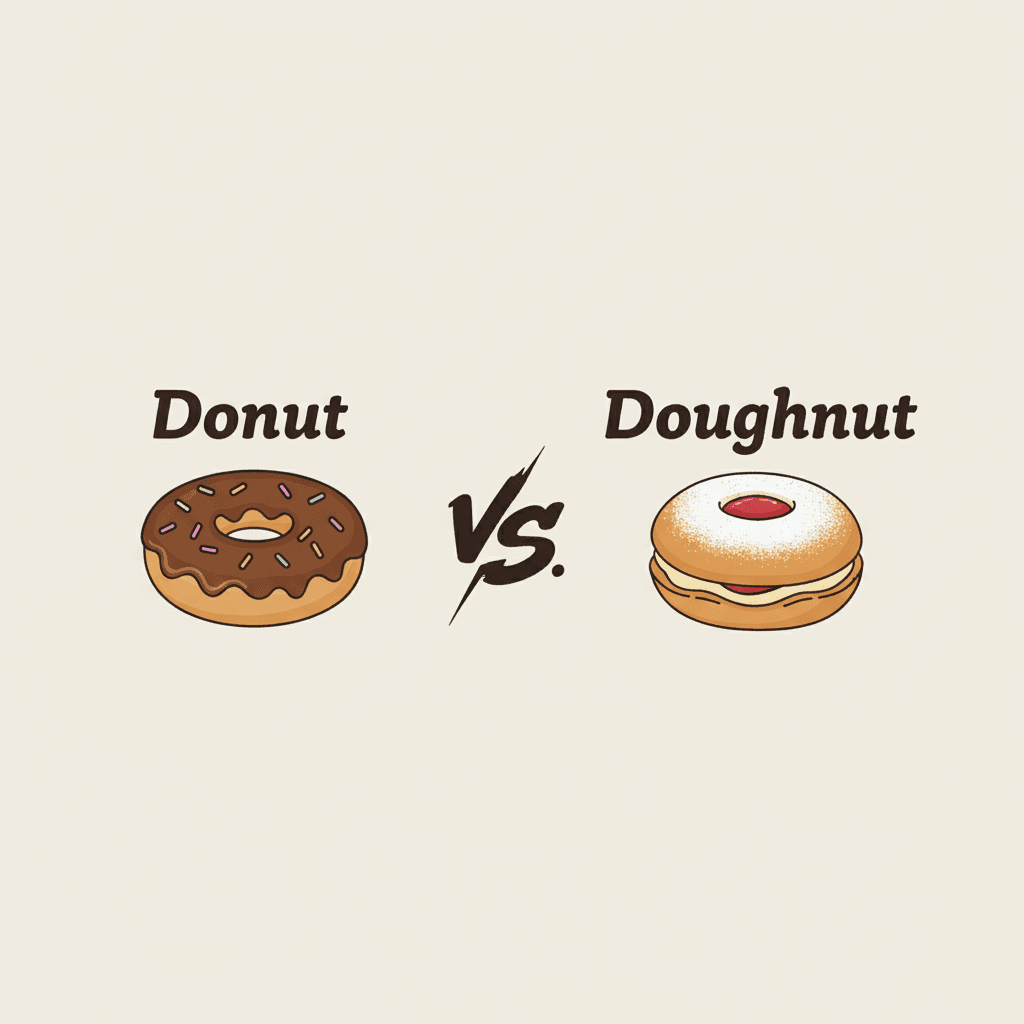Donut vs. Doughnut: What’s the Difference?
 Both donut and doughnut refer to the same delicious treat — a ring-shaped, deep-fried pastry.
Both donut and doughnut refer to the same delicious treat — a ring-shaped, deep-fried pastry.
The only difference is spelling, style, and formality — not meaning.
Here’s the quick rule:
- Doughnut → the original, traditional spelling (formal).
- Donut → the modern, simplified spelling (informal and American).
1. Doughnut: The Original Spelling
Meaning
“Doughnut” is the older and original spelling, first appearing in English around the early 1800s.
It combines “dough” (the mixture) + “nut” (old slang for a small round shape).
Examples (10 total)
- She bought a chocolate doughnut for breakfast.
- The bakery sells glazed doughnuts every morning.
- Would you like a jelly-filled doughnut?
- The box contains twelve assorted doughnuts.
- He grabbed a doughnut and a cup of coffee.
- Police officers stereotypically love doughnuts.
- I made homemade doughnuts last weekend.
- These doughnuts are soft and sugary.
- She couldn’t resist the smell of fresh doughnuts.
- We stopped at a famous doughnut shop in Boston.
🧠 Tip:
If you’re writing for formal, international, or academic audiences, use doughnut.
2. Donut: The Modern Spelling
Meaning
“Donut” is a simplified, Americanized version of doughnut.
It became popular in the 20th century, largely thanks to Dunkin’ Donuts, which branded the shorter spelling.
Examples (10 total)
- I grabbed a chocolate donut on my way to work.
- The shop sells mini donuts for kids.
- Let’s stop for coffee and donuts.
- The donut truck is parked near the park.
- He loves maple-glazed donuts.
- My favorite donut has sprinkles.
- They’re opening a gourmet donut café downtown.
- The smell of fresh donuts filled the air.
- We bought pink donuts for the office.
- She made a funny face out of her donut.
🧠 Tip:
Use donut for casual, American, or marketing writing.
3. Quick Comparison Table
| Word | Correct? | Origin | Use In | Tone |
|---|---|---|---|---|
| Doughnut | ✅ Yes | Traditional (1800s) | British & formal English | Proper / classic |
| Donut | ✅ Yes | Modern (1900s, U.S.) | American & informal | Casual / modern |
4. How to Remember
👉 Doughnut → “dough” reminds you it’s made of dough.
👉 Donut → looks simpler, like fast food branding.
💡 Memory Trick:
“Doughnut” for formal writing; “Donut” for fun writing.
5. Common Mistakes
❌ Donut is slang and not a real word.
✅ Donut is recognized by dictionaries like Merriam-Webster and Oxford as a valid variant.
❌ Only Americans use donut.
✅ Mostly true — donut is dominant in the U.S., but recognized worldwide.
6. Why Both Exist
When Dunkin’ Donuts popularized the shorter version in the 1950s, Americans quickly adopted it in everyday use.
However, traditional writers and British English still prefer doughnut.
Today, both are correct — your choice depends on tone and region.
Even AI grammar tools sometimes suggest one over the other, but Humanizey ensures consistency based on your writing style and target audience.
FAQs
1. Is “donut” grammatically correct?
Yes. It’s an accepted variant of doughnut in all major English dictionaries.
2. Which spelling do Americans use more?
Donut is more common in the U.S. (especially in branding), while doughnut is used in formal writing.
3. Which one is British?
Doughnut is the standard spelling in the U.K. and other Commonwealth countries.
4. Should I use “donut” in an essay?
No. Stick with doughnut in academic or professional writing.
Practice: Choose the Correct Form (“Donut” or “Doughnut”)
(Answers are listed at the end.)
- The bakery sells dozens of glazed ___.
- I bought a chocolate ___ from Dunkin’.
- British people usually write ___.
- My favorite ___ is filled with jam.
- The café’s sign says “Hot Fresh ___!”
Answers
- doughnuts
- donuts
- doughnut
- doughnut
- donuts
